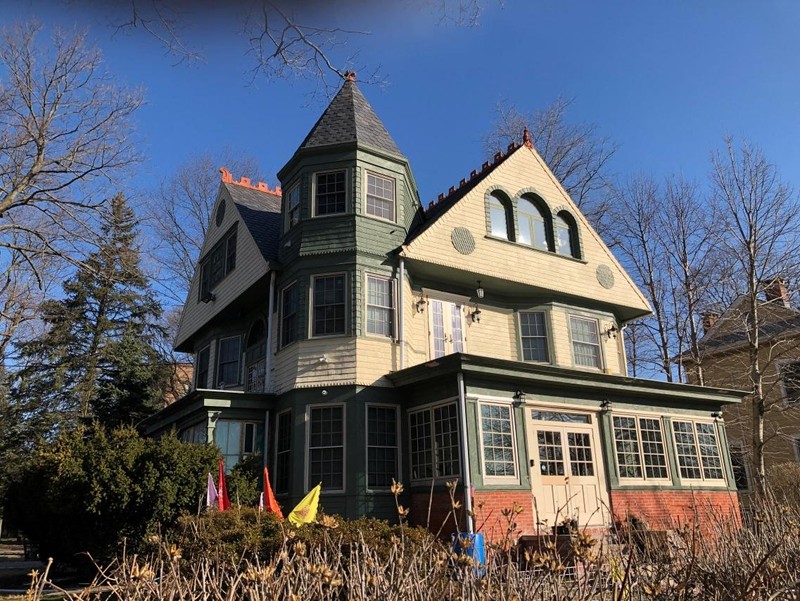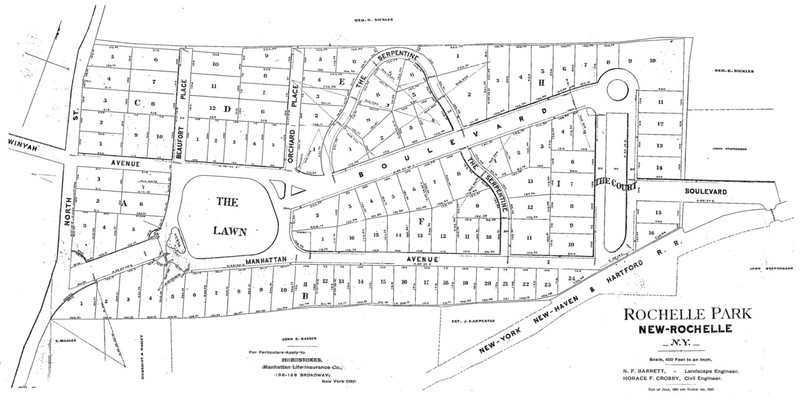8 The Circle (Rochelle Park-Rochelle Heights Historic District)
Introduction
Text-to-speech Audio
The Rochelle Park-Rochelle Heights Historic District in New Rochelle, NY, is comprised of over 270 residential buildings in two historic neighborhoods. The house located at 8 The Circle in Rochelle Park was constructed in 1885 for Henry Siebrecht, the nationally-renowned florist, landscape designer, and founder of Rose Hill Nurseries in New Rochelle. This Shingle-style residence exemplifies the first homes constructed in Rochelle Park, including features that provided views of Long Island Sound. Fronting the common space referred to as “The Lawn,” the house was truly in a park-like setting, the overall intention of this early “residential park” that is now the Rochelle Park-Rochelle Heights Historic District. In 1986, Rochelle Park-Rochelle Heights was locally designated a historic neighborhood by the New Rochelle Historical Landmarks and Review Board. The Rochelle Park-Rochelle Heights Historic District, including 8 The Circle, was placed on the National Register of Historic Places in 2005.
Images

Rochelle Park map

Backstory and Context
Text-to-speech Audio
Completed in 1885, 8 The Circle was designed in the Shingle style, an architectural design that was popular during Rochelle Park’s initial construction period. Although the roof’s original shingles have been replaced, the original shingles remain on the exterior walls, wrapping around the building’s tower and tying together diverse forms. The structure possesses irregularly shaped windows and presents an asymmetrical design, two elements common to the Shingle style. The three-story tower, a component also found on a number of other homes in the district, once afforded views of Long Island Sound. Views were also maximized by the attic porch, situated on the wide front gable and behind arcade-like windows.
The home was built for German-born Henry Siebrecht, which may have resulted in decorative “Bavarian” features such the metal crenelation along the roof line and the faceted metal roof. Due to his occupation as a landscape designer, it is likely that Henry Siebrecht chose the plot for his home because it overlooked “The Lawn,” one of the common open areas incorporated into the aesthetically-pleasing, park-like design of the development.
Henry Siebrecht was a nationally-renowned florist and founder of Rose Hill Nurseries. In 1866, at the age of 17, Siebrecht emigrated from Germany, arriving in Hoboken, NJ, with a bag filled with only a few belongings and eleven dollars. Using the horticultural training that he had received at the University of Gottingen, he immediately found a job at Buchanan's nursery in Astoria, Long Island (now Queens.) Just two years later Siebrecht was creating some of America's first and finest floral wedding bouquets in the confines of his own Manhattan florist shop. He would earn the title "Father of Fifth Avenue," as he became the florist and neighbor of such notables as Russell Sage, Andrew Carnegie, J. Pierpont Morgan, General Ulysses Grant, P.T. Barnum, and Boss Tweed. By 1878 Siebrecht purchased 40 acres in New Rochelle for a nursery. He would amass 90 acres along North Avenue, on land that extended to the Hutchinson River. Inside the 68 enormous greenhouse grew flowers never before seen in America, such as the Killarney rose, winter-blooming lilies of the valley, and orchids.
His landscape architecture endeavors were as prolific and illustrious as his horticultural work. In addition to working with Nathaniel Britten in laying what is now known as the New York Botanical Garden, Siebrecht also assisted with the design of the extensive Fairmount Park in Philadelphia, and the transformation of Coney Island into a pleasure resort. He also had a hand in P.T. Barnum's Hippodrome and subsequent Gilmore Gardens, the World's Fairs in New York and Chicago, the Philadelphia Centennial, and the San Francisco Fair. Among his long list of notable private gardens were those of Thomas Edison in New Jersey and John D. Rockefeller, Sr. at Pocantico Hills in Westchester County, NY.
When New Rochelle was incorporated as a city in 1899, Siebrecht was one of the first eight aldermen. Later, as a member of City Council, he was dubbed the "Father of North Avenue," having been responsible for widening North Street to become North Avenue. In 1923 Siebrecht dismantled his renowned nurseries, reestablishing a fraction of them in Boynton, Florida. He died in 1934 at the age of 85. In the late 1920s a former employee of Rose Hill Nurseries purchased the name for his own enterprise. Today, a descendant of that employee continues to operate a business called “Rose Hill Nurseries,” at 975 Webster Avenue in New Rochelle.
Sources
- Davis, Barbara. “A Career Blooms in City.” Soundings, Gannett Sound Shore Newspapers. May 11, 1995.
- “H. A. Siebrecht Dies; Landscape Artist.” New York Times. June 20, 1934. Pg 21.
- “Rochelle Park-Rochelle Heights Historic District.” National Register of Historic Places. United States Department of the Interior/National Park Service. 2005. https://catalog.archives.gov/id/75323193
- Williams, Gray. Picturing Our Past: National Register Sites in Westchester County. Westchester County Historical Society. 2003.
Westchester County Archives
